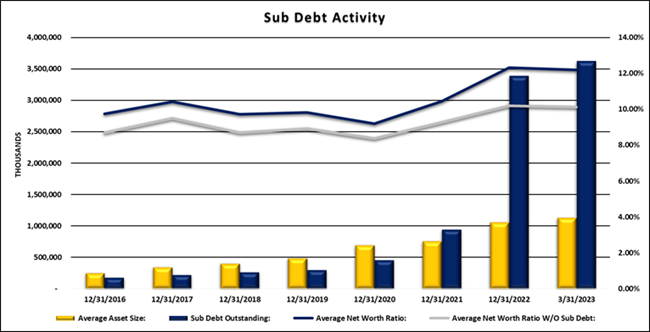By Mark DeBree, CFA, Catalyst Strategic Solutions Managing Principal
Subordinated debt usage has exploded over recent years. Since the end of 2017, total outstanding subordinated debt has increased from $223.5 million to over $3.6 billion.

Admittedly, the U.S. Treasury Emergency Capital Investment Program (ECIP) helped spur the growth, adding $1.9 billion in subordinated debt during 2022. Excluding the ECIP program contributions, subordinated debt still shows a significant $1.7 billion increase, up approximately $1.5 billion since year-end 2017. If the pace continues, 2023 issuances will likely surpass 2022 issuances.
Also noteworthy is the asset sizes of credit unions turning to subordinated debt as a strategic tool. At the end of 2016, the average asset size of credit unions issuing subordinated debt was $250 million. In the first quarter of 2023, the average asset size exceeded $1.1 billion.
Overall strength of issuing credit unions has also increased. The adjusted net worth ratios (net worth less subordinated debt) have increased from 8.69% at the end of 2016 to over 10%, as of March 31, 2023.
Why has activity increased?
In the past, subordinated debt was issued by smaller credit unions with lower net worth positions to help them sustain operations. Now, larger credit unions are also turning to subordinated debt, not to sustain operations, but rather as a means of increasing net worth to fuel growth and expansion opportunities.
Subordinated debt is eligible for net worth treatment if the issuing credit union is low-income-designated or expects to achieve a low-income-designation within two years AND obtain prior written approval from the NCUA and their state examiners (if state chartered).
“The potential to count subordinated debt toward net worth is the single most appealing factor driving issuance.”
The net worth treatment allows a credit union to grow deposits and loans upon acceptance. Of course, subordinated debt is not a cure-all and should be pursued with caution. Managers must have confidence in their ability to grow and expand to make the strategy valuable to their membership.
Subordinated debt is as an excellent tool for credit unions with growth potential and capabilities that are restricted by their capital levels. Adding net worth through subordinated debt can ease growth limitations, enable credit unions to grow and bring value to more members within their existing or surrounding communities.
For greater insights into subordinated debt issuance, including strategies driving credit union issuances, guidelines for how much credit unions should issue, how to analyze the cost of issuances and profitability comparisons showing the impact of net worth treatment, contact our Advisory Services team access our full “Subordinated Debt Growth Continues” whitepaper here.